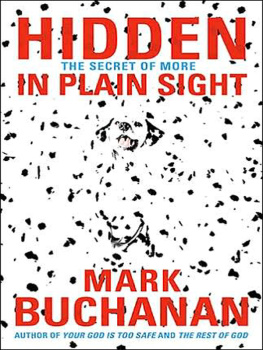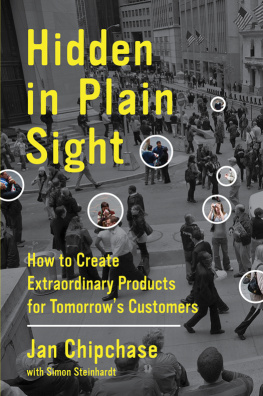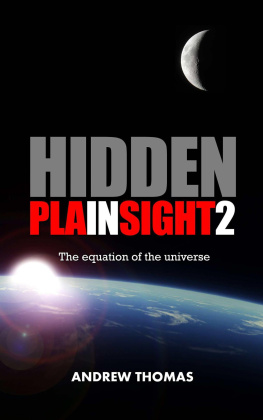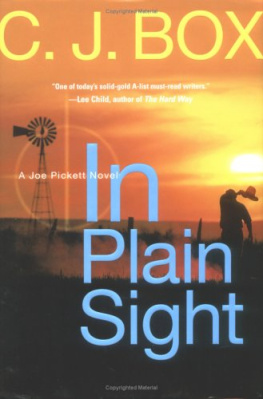David C. Krakauer - Worlds Hidden in Plain Sight
Here you can read online David C. Krakauer - Worlds Hidden in Plain Sight full text of the book (entire story) in english for free. Download pdf and epub, get meaning, cover and reviews about this ebook. year: 2019, publisher: Santa Fe Institute, genre: Politics. Description of the work, (preface) as well as reviews are available. Best literature library LitArk.com created for fans of good reading and offers a wide selection of genres:
Romance novel
Science fiction
Adventure
Detective
Science
History
Home and family
Prose
Art
Politics
Computer
Non-fiction
Religion
Business
Children
Humor
Choose a favorite category and find really read worthwhile books. Enjoy immersion in the world of imagination, feel the emotions of the characters or learn something new for yourself, make an fascinating discovery.

- Book:Worlds Hidden in Plain Sight
- Author:
- Publisher:Santa Fe Institute
- Genre:
- Year:2019
- Rating:5 / 5
- Favourites:Add to favourites
- Your mark:
- 100
- 1
- 2
- 3
- 4
- 5
Worlds Hidden in Plain Sight: summary, description and annotation
We offer to read an annotation, description, summary or preface (depends on what the author of the book "Worlds Hidden in Plain Sight" wrote himself). If you haven't found the necessary information about the book — write in the comments, we will try to find it.
Worlds Hidden in Plain Sight — read online for free the complete book (whole text) full work
Below is the text of the book, divided by pages. System saving the place of the last page read, allows you to conveniently read the book "Worlds Hidden in Plain Sight" online for free, without having to search again every time where you left off. Put a bookmark, and you can go to the page where you finished reading at any time.
Font size:
Interval:
Bookmark:


[Worlds Hidden in Plain Sight]
The Evolving Idea of Complexity at the Santa Fe Institute
19842019
editor
Acknowledgments
The SFI Press would not exist without the support of William H. Miller and the Miller Omega Program, Andrew Feldstein and the Feldstein Program on History, Law, and Regulation, and Alana Levinson-Labrosse.
2019 Santa Fe Institute
All rights reserved.
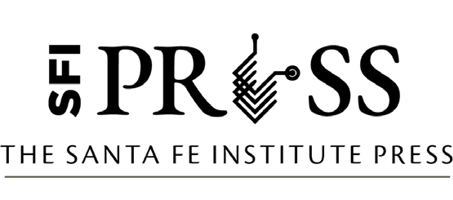
1399 Hyde Park Road
Santa Fe, New Mexico 87501
Worlds Hidden in Plain Sight:
The Evolving Idea of Complexity at the Santa Fe Institute
isbn (paperback): 978-1-947864-15-3
Library of Congress Control Number: 2019904092
Chapters 1-22 of this volume were originally published in the SFI Bulletin. Chapters 23-36 were first published by Christian Science Monitor as part of the Complexity series, supported by Arizona State University.
Essays republished with permission, lightly edited for this edition.
The SFI Press is supported by the Feldstein Program on History, Regulation, & Law, the Miller Omega Program, and Alana Levinson-LaBrosse.
One has the feeling that this set of samples from the universal Waste Land is on the point of revealing something important to us: a description of the world?
Italo Calvino
Collection of Sand (1984)
Editor & Author
David C. Krakauer , Santa Fe Institute
Authors
Kenneth Arrow , Stanford University
W. Brian Arthur , Santa Fe Institute and Palo Alto Research Center
Rob Axtell , George Mason University
Lus M.A. Bettencourt , Santa Fe Institute
Seth Blumsack , Penn State University
Samuel Bowles , Santa Fe Institute
Christa Brelsford , Santa Fe Institute and Arizona State University
John Casti , University of Vienna
Aaron Clauset , University of Colorado Boulder
George Cowan Santa Fe Institute
Simon DeDeo , Indiana University
Jennifer A. Dunne , Santa Fe Institute
Joachim Erber , Technical University of Berlin
J. Doyne Farmer , Institute for New Economic Thinking
Jessica C. Flack , University of Wisconsin-Madison and the Santa Fe Institute
Mirta Galei , Santa Fe Institute
Murray Gell-Mann , Caltech
David Gray , Boston Consulting Group
Marcus J. Hamilton , Santa Fe Institute
John H. Holland , University of Michigan
Molly Jahn , University of Wisconsin-Madison
Tom Kepler , Santa Fe Institute
Daniel B. Larremore , Santa Fe Institute
Manfred D. Laubichler , Arizona State University
Simon Levin , Princeton University
Richard C. Lewontin , Harvard University
Seth Lloyd , Massachusetts Institute of Technology
Andrew Lo , Massachusetts Institute of Technology
Michele Macready , Boston Consulting Group
Lord Robert May , Oxford University
John H. Miller, Santa Fe Institute and Carnegie Mellon University
Harold Morowitz , George Mason University
Scott G. Ortman , Santa Fe Institute
Robert E. Page , University of California, Davis
Richard Palmer , Duke University
Marty Peale , freelance writer
Ole Peters , Imperial College London
Daniel Rockmore , Dartmouth University
Paula L.W. Sabloff , Santa Fe Institute
Cosma Shalizi , University of Wisconsin and Santa Fe Institute
D. Eric Smith , Santa Fe Institute
Geoffrey B. West, Santa Fe Institute
Note: Affiliations and publication status of works referenced listed in this volume are as of the original essay publication date.
Table of Contents
, David C. Krakauer
, John H. Holland
, George Cowan and Kenneth Arrow
, Richard Palmer
, Murray Gell-Mann
, John Casti
, Seth Lloyd
, Simon Levin
, Cosma Shalizi
, Joachim Erber and Robert E. Page, Jr.
, Tom Kepler
, Richard C. Lewontin
, D. Eric Smith and Harold J. Morowitz
, David Gray and Michele Macready
, Daniel Rockmore
, Ole Peters
, David C. Krakauer
, Lord Robert May
, Scott G. Ortman
, W. Brian Arthur
, Jessica C. Flack
, David C. Krakauer
, Lus M.A. Bettencourt and Geoffrey B. West
, Rob Axtell and J. Doyne Farmer
, Jennifer A. Dunne and Marcus J. Hamilton
, Jessica C. Flack and Manfred D. Laubichler
, Mirta Galei
, John H. Miller
, Simon DeDeo
, Samuel Bowles
, Christa Brelsford
, Simon Levin and Andrew Lo
, John H. Miller
, Paula L.W. Sabloff
, Molly Jahn
, Seth Blumsack
, Daniel B. Larremore and Aaron Clauset
, David C. Krakauer
They consider only their own ideas of ingenuity; and, in searching for anything hidden, advert only to the modes in which they would have hidden it.
Edgar Allan Poe, The Purloined Letter (1845)
What explains our obsession with the hidden?
Whence comes our enduring belief that truth is not to be found by means of immediate perception but through extreme efforts at augmenting what can be sensed with manufactured instruments? It is as if every scientific project were a crime scene, the perpetrators long since fled, leaving a few clumsy crumbs of evidence for researchers to puzzle over with magnifying lens and graphite powder.
From classical antiquity and its obsession with geometric order beyond manifest reality, followed by the late Renaissance conviction that everything in nature expresses an unfathomable divine intention, on through to the modern age with its instruments required to reveal the elemental nature of reality (microscopes, telescopes, particle colliders, mass spectrometers), what is causally primary is always thought to be buried deep beneath the surface of the obvious.
Traditionally things can be hidden in two fundamentally different ways. Things can be hidden in space, and they can be hidden in time.
To hide in space means that phenomena lie beyond the scope of our everyday senses because they are either too small or too distant to be detected without amplification. Things can be hidden in time by being too fast for us to perceive or too slow for a single lifetime to encompass.
And, given our extraordinarily bandwidth-limited cognition and the fleeting nature of an individual life, it comes as no surprise that by far the majority of natural phenomena would be hidden.
It has been the great triumph of the sciences to find consistent means of studying natural phenomena hidden by both space and timeovercoming the limits of cognition and material culture. The scientific method is the portmanteau of instruments, formalisms, and experimental practices that succeed in discovering basic mechanisms despite the limitations of individual intelligence.
There are, however, on this planet phenomena that are hidden in plain sight. These are the phenomena that we study as complex systems: the convoluted exhibitions of the adaptive worldfrom cells to societies.
Paradoxically the complex world is one that we can in many senses perceive and measure directly. Unlike distant stars or nearby minerals that require a significant increase in optical capability to arrive at insights into their elementary properties, behaviorboth individual and collectiveseems to present itself in a way that can be investigated rather modestly, through observation, or through experiment.
Font size:
Interval:
Bookmark:
Similar books «Worlds Hidden in Plain Sight»
Look at similar books to Worlds Hidden in Plain Sight. We have selected literature similar in name and meaning in the hope of providing readers with more options to find new, interesting, not yet read works.
Discussion, reviews of the book Worlds Hidden in Plain Sight and just readers' own opinions. Leave your comments, write what you think about the work, its meaning or the main characters. Specify what exactly you liked and what you didn't like, and why you think so.


